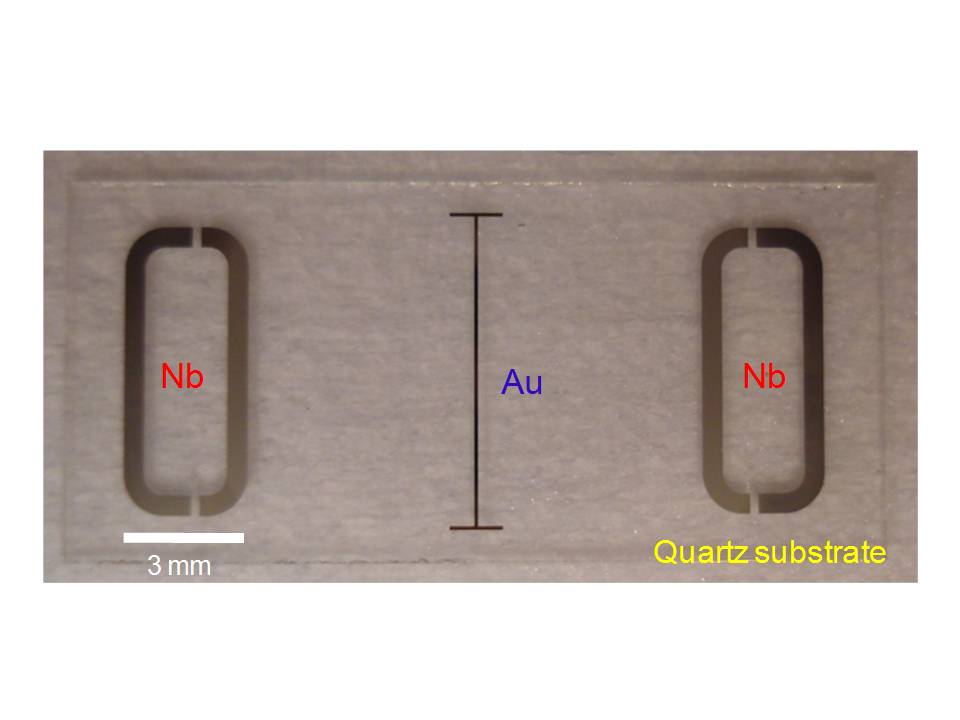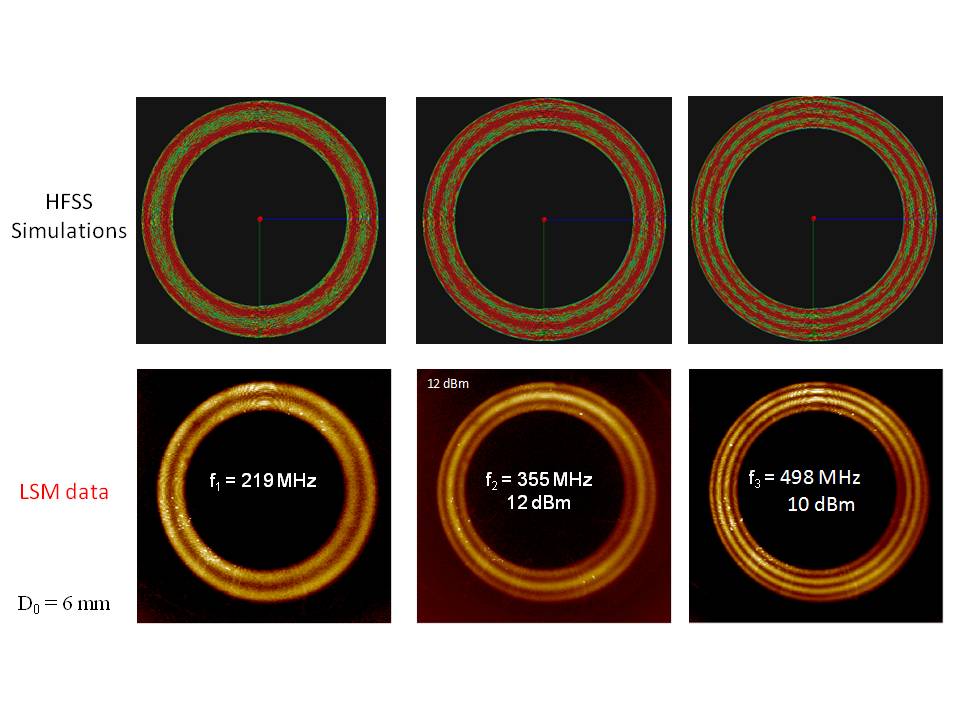
Anlage Research Group |
| High Frequency Superconductivity, Microscopy, Nanophysics, and Chaos |
Affiliations:
Materials with a negative index of refraction (NIR) were originally proposed in 1967 by V. G. Veselago, "The Electrodynamics of Substances With Simultaneously Negative Values of e and m," Usp. Fiz. Nauk 92, 517-526 (1967) [English translation: Sov. Phys. Usp. 10, 509-514 (1968)].
Veselago coined the phrase "left-handed substance"
in this paper. These materials are often known as Left-Handed Materials
(LHM). The Poynting vector S is in the opposite direction to the wave
vector k in an NIR material. The wavevector k is in the direction of the
phase velocity, while the group velocity points in the opposite direction.
He states that NIR is equivalent to "substance with negative group
velocity."
His predictions include:
- Reversed Doppler Effect. A detector moving in an LHM
would perceive fewer wave fronts if it was moving towards the source
because of the reversal of the phase velocity. The opposite occurs if
the receiver is in an LHM moving away.
- Reversed Cerenkov Effect. The cone of light emission
in an LHM will be backward relative to the direction of motion of the
particle.
- Negative Refraction. At a boundary between two media,
1 and 2, the tangential components of E and H are continuous. However,
the normal components can change sign if the two media have opposite
signs for the index of refraction. This will cause the refracted ray
to be on the same side of the normal as the incident ray. Note that
there is no change in the reflected ray.
- n=-1 Flat Lensing. Predicts that a flat slab of n=-1
material will focus rays from a point source a distance l from the left-hand
side of the slab to a point image a distance d-l from the right-hand
side of the slab, where d is the slab thickness. Pendry (2000) later
predicted that these images would be "perfect" under ideal
circumstances.
- Reversal of Optical Refracting Elements. Predicts that
n=-1 concave and convex lenses will switch roles as compared to n>0
versions of these lenses.
- Reversal of Radiation Pressure. A monochromatic wave
in an LHM is a stream of photons with k pointing toward the source,
and p = hk. When absorbed, these photons will impart negative momentum
and create radiation tension rather than pressure.
- Dispersion Requirement. Veselago argues that e
and m cannot
be negative at all frequencies because it would lead to a negative total
energy W.
Compelling experimental evidence for NIR/LHM behavior has been seen through negative index passbands, negative refraction, and apparent super-resolution imaging. These demonstrations have been made at room temperature in artificial loop-wire, dual circuit, and photonic crystal media.
An important prediction for NIR materials is evanescent wave amplification
under the ideal condition of n = -1 + i 0 precisely. This property
will permit, in principle, image reconstruction with arbitrary precision
and detail as demonstrated, for example, in calculations of flat-lens
transfer functions. However, these theoretical works also show that ideal
evanescent wave amplification suffers from three important constraints;
the real part of n must be -1, exactly, the metamaterial must be thin
(compared to the wavelength) to minimize retardation effects, and the
imaginary part of n must be much less than 1, so that there is very little
damping. The first two constraints can be satisfied, in principle, with
appropriate engineering of existing metamaterials. However, significant
losses have a debilitating effect on most designs. We utilize superconducting metamaterials to minimize loss and enable new properties. Our work has established the field of superconducting metamaterials and shown how it can be used to create novel manipulations of RF and microwave signals. Superconductors also introduce strong nonlinearity, and this too can be exploited to create remarkable new effects.
Prof. Anlage talk: "Physics and Applications of Negatively Refracting Electromagnetic Materials"
Michael Ricci's Ph.D. thesis
News article about our Radio Frequency Superconducting Metamaterials
Recent review articles about metamaterials: Eleftheriades; Itoh; Jung
Our work featured in a Special Issue of Physical Review X
Our work has focused on developing low loss and extremely nonlinear superconducting metamaterials. The work is supported by the National Science Foundation NSF/ECS-0322844, the NSF-GOALI program through grant #ECCS-1158644, and the DNI Post-Doc program. We thank Peter Kneisel and Larry Turlington of Jefferson Lab for their assistance in the fabriaction of our bulk Niobium superconducitng metamaterials.
Some relevant papers: (All papers can be downloaded from the full publication list)
Michael Ricci, Nathan Orloff, and Steven M. Anlage, "Superconducting Metamaterials," Appl. Phys. Lett. 87, 034102 (2005). pdf
Michael Ricci, and Steven M. Anlage, “Single Superconducting Split-Ring Resonator Electrodynamics,” Appl. Phys. Lett. 88 , 264102 (2006). pdf
Michael Ricci, Hua Xu, Steven M. Anlage, Ruslan Prozorov, Alexander P. Zhuravel, and Alexey Ustinov , “Tunability of Superconducting Metamaterials,” IEEE Trans. Appl. Supercond. 17, 918 - 921 (2007). DOI: 10.1109/TASC.2007.898535 . pdf
Cihan Kurter, Steven M. Anlage, “Superconductivity takes the stage in the field of metamaterials,” SPIE Newsroom, February (2010). DOI: 10.1117/2.1201002.002543. pdf
Steven M. Anlage. "The Physics and Applications of Superconducting Metamaterials," J. Opt. 13, 024001 (2011). pdf
Cihan Kurter, John Abrahams, Steven M. Anlage, “Miniaturized Superconducting Metamaterials for Radio Frequencies,”Appl. Phys. Lett. 96, 253504 (2010). pdf
C. Kurter, A. P. Zhuravel, J. Abrahams, C. L. Bennett, A. V. Ustinov, S. M. Anlage, “Superconducting RF Metamaterials Made with Magnetically Active Planar Spirals,” IEEE Trans. Appl. Supercond. 21, 709-712 (2011). pdf
Lei Zhang, Philippe Tassin, Thomas Koschny, Cihan Kurter, Steven M. Anlage, and C. M. Soukoulis, “Large group delay in a microwave metamaterial analogue of electromagnetically induced transparency,” Appl. Phys. Lett. 97, 241904 (2010). pdf
Cihan Kurter, Alexander P. Zhuravel, Alexey V. Ustinov, Steven M. Anlage, “Microscopic examination of hot spots giving rise to nonlinearity in superconducting resonators,” Phys. Rev. B 84, 104515 (2011). pdf
Cihan Kurter, Philippe Tassin, Lei Zhang, Thomas Koschny, Alexander P. Zhuravel, Alexey V. Ustinov, Steven M. Anlage, and Costas M. Soukoulis, “Classical Analogue of Electromagnetically Induced Transparency with a Metal/Superconductor Hybrid Metamaterial,” Phys. Rev. Lett. 107, 043901 (2011). pdf
Cihan Kurter, Philippe Tassin, Alexander P. Zhuravel, Lei Zhang, Thomas Koschny, Alexey V. Ustinov, Costas M. Soukoulis, and Steven M. Anlage, “Switching Nonlinearity in a Superconductor-Enhanced Metamaterial,” Appl. Phys. Lett. 100, 121906 (2012). pdf
A. P. Zhuravel, C. Kurter, A. V. Ustinov, and S. M. Anlage, “Unconventional RF Photo-Response from a Superconducting Spiral Resonator,” Phys. Rev. B 85, 134535 (2012). pdf.
Behnood G. Ghamsari, John Abrahams, Cihan Kurter, and Steven M. Anlage, “High-Temperature Superconducting Spiral Resonator for Metamaterial Applications,”IEEE Trans. Appl. Supercond. 23, 1500304 (2013). pdf
Behnood G. Ghamsari, John Abrahams, Steven M. Anlage, “High-Temperature Superconducting Multi-Band Radio-Frequency Metamaterial Atoms,”Appl. Phys. Lett. 102, 013503 (2013). pdf
V. Savinov, V. A. Fedotov, S. M. Anlage, P. A. J. de Groot, N. I. Zheludev, “Modulating Sub-THz Radiation with Current in Superconducting Metamaterial,” Phys. Rev. Lett. 109, 243904 (2012). pdf
M. Trepanier, Daimeng Zhang, Steven M. Anlage, Oleg Mukhanov, “Realization and Modeling of Metamaterials Made of rf Superconducting Quantum-Interference Devices,” Phys. Rev. X 3, 041029 (2013). pdf
Cihan Kurter, J. Abrahams, G. Shvets, Steven M. Anlage, “Plasmonic Scaling of Superconducting Metamaterials,” Phys. Rev. B 88, 180510(R) (2013). pdf
Philipp Jung, Alexey V. Ustinov, Steven M. Anlage, “Progress in Superconducting Metamaterials,” Supercond. Sci. Technol. 27 073001 (2014). pdf
C. Kurter, T. Lan, L. Sarytchev, and Steven M. Anlage, “Tunable negative permeability in a three-dimensional superconducting metamaterial,” Phys. Rev. Applied 3, 054010 (2015). Physics Synopsis: Superconducting Antennas Tune In Editors’ Suggestion. pdf
Daimeng Zhang, Melissa Trepanier, Oleg Mukhanov, and Steven M. Anlage, “Tunable Broadband Transparency of Macroscopic Quantum Superconducting Metamaterials,” Phys Rev. X 5, 041045 (2015). pdf
Daimeng Zhang, Melissa Trepanier, Thomas Antonsen, Edward Ott, Steven M. Anlage, “Intermodulation in Nonlinear SQUID Metamaterials: Experiment and Theory," Phys. Rev. B 94, 174507 (2016). pdf
Melissa Trepanier, Daimeng Zhang, Oleg Mukhanov, V. P. Koshelets, Philipp Jung, Susanne Butz, Edward Ott, Thomas M. Antonsen, Alexey V. Ustinov, Steven M. Anlage, “Coherent Oscillations of Driven rf SQUID Metamaterials," Phys. Rev. E 95, 050201(R) (2017). pdf
Alexander P. Zhuravel, Seokjin Bae, Alexander V. Lukashenko, Alexander S. Averkin, Alexey V. Ustinov and Steven M. Anlage, “Imaging collective behavior in an rf-SQUID metamaterial tuned by DC and RF magnetic fields,” Appl. Phys. Lett. 114, 082601 (2019). pdf
Melissa Trepanier, Daimeng Zhang, Lyudmila Filippenko, Valery Koshelets, Steven M. Anlage, “Tunable Superconducting Josephson Dielectric Metamaterial,” AIP Advances 9, 105320 (2019). (Editor's Pick). pdf
Phone: (301) 405-7321 Fax: (301) 405-3779
Copyright © 2008 University of Maryland
Contact us with comments, questions and feedback

